My Toner Tam is a cross between a French beret and a Scottish tam
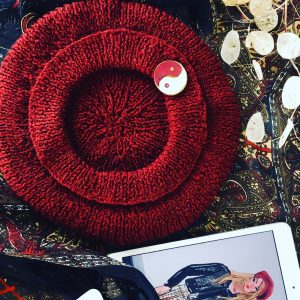
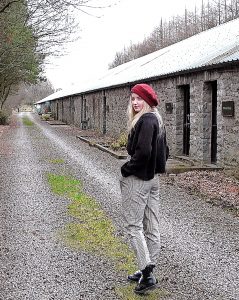
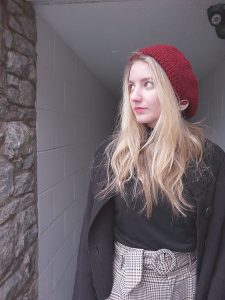
Beret
The classic French beret became synonymous with bohemian artists and writers in Paris. But, it was really the 17thcentury shepherds from the Basque region of France who were early adopters. They used the felted wool from their own sheep to keep their heads warm and dry. The classic French beret had a little tail from the end of the knitting which came out of the crown, the hat was knitted then felted on a wooden disc. In the 1930s Chanel adapted it for women, maybe after seeing Marlene Deitrich wearing one on stage. This made it a fashion statement for other women, including movie stars such as Greta Garbo and Brigitte Bardot. Parisian artists of the Left Bank imitated the great artists of the Renaissance, adopting the beret as part of their arty image.
Kangol hats
I grew up near the Kangol factory, where 80% of all French berets were produced. They used wool, angora and thermoplastic fibre, to help the beret keep its shape in the rain. My Tam (above) is knitted with Cumbria Fingering yarn, kindly donated by The Fibre Company through their yarn support programme. I chose the beautiful ‘Appleby Castle’ red as I felt it had the rich and confident quality which matched the style. The fibre is 60% merino wool, 30% masham wool and 10% mohair, which gives a lovely bloom, warmth and softness to the finished product. Knit using increases, decreases, 1 x 1 Rib, from the bottom up on circular needles with a back seam, but can also be worked on straight needles if you prefer.
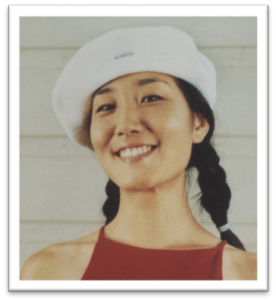
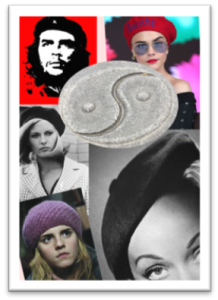
4. Photo of white Kangol beret 5. Collage of films stars and revolutionaries
The name Kangol (started by Jakob Spreiregen), refers to the ‘K’ from Knitting or Knitted, the ‘ANG’ from angora, the ‘OL’ from wool. The textile industry in the English/Scottish Borders where I live was a big part of my history. Kangol was the reason why I first became interested in millinery. Their knitted and felted berets: an iconic fashion piece were manufactured in Cumbria from 1938-2010 by Kangol. The tam/beret remains a symbol of French and Scottish culture, youth, rebellion, revolution, defense of freedom and country due to its military traditions.
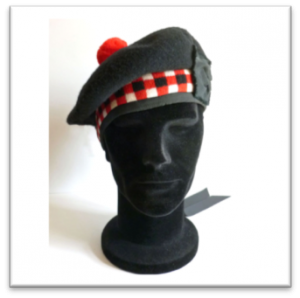
6. Example of Scottish Military Caps, the Tam o’shanter
Tam o’shanter hat
My version of the beret is crossed with the Scottish Tam o’shanter. (A name derived from the character in a poem by Robert Burns from Dumfries, in the Scottish Borders.)
“But pleasures are like poppies spread:
You seize the flower, its bloom is shed;
Or like the snowfall on the river,
A moment white – then melts forever,…” Robert Burns, 1790.
There was a white moment, with a light fall of snow as Beth modeled the hat. The Tam was used as a Scottish military cap and was called the ‘Blue Bonnet’, due to the natural dye colours used, indigo and woad. They wore the tam band an inch above the eyebrow and pulled down over the right ear. You can wear yours any way you want, pulled right back, on the top or side, over your ears, or like a slouchy beanie. I have blocked mine into a traditional disc shape for a slanted chic style.
On this occasion, I didn’t use traditional tartan, tweed or pom poms. Instead, I took the baggy shape and deeper headband of the Tam to add British style to the French beret. As for decor, I added the insignia of a yin yang badge as its balance sums up the concept of the beret, perfect for young and old and male and female alike. It is a practical hat, warm and can be tucked in your pocket when it’s not needed. But it’s more than just a head covering. The Toner Tam is meant to be a statement to add attitude, that adapts to anyone’s personal style. Wear your own personal brooch or badge. It is the perfectly inclusive hat, from performers to shepherds, rebels to artists, casual to couture the Tam can identify character and convey the mood of its wearer.
Go to https://www.ravelry.com/designers/maggi-toneredgar for the pattern and wool.
Happy knitting!
Maggi

